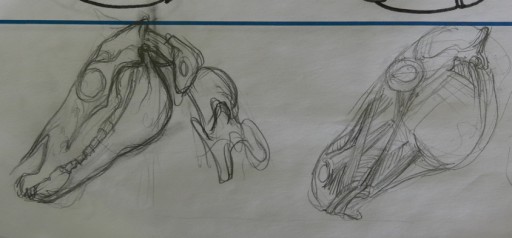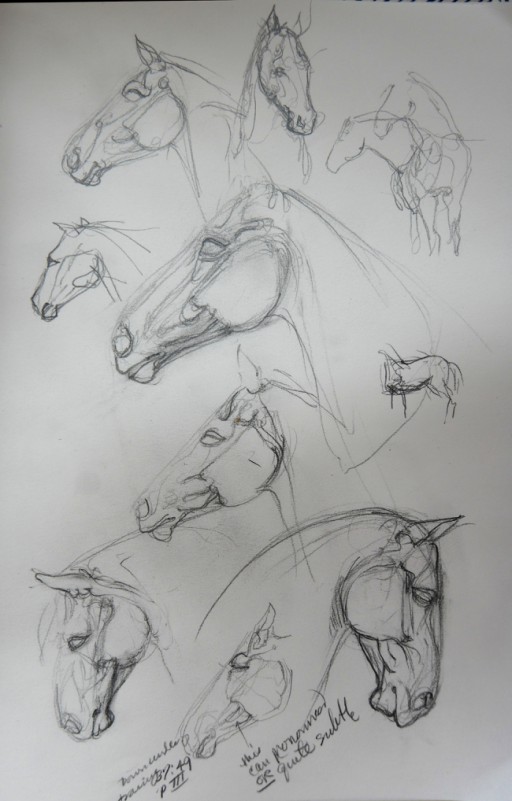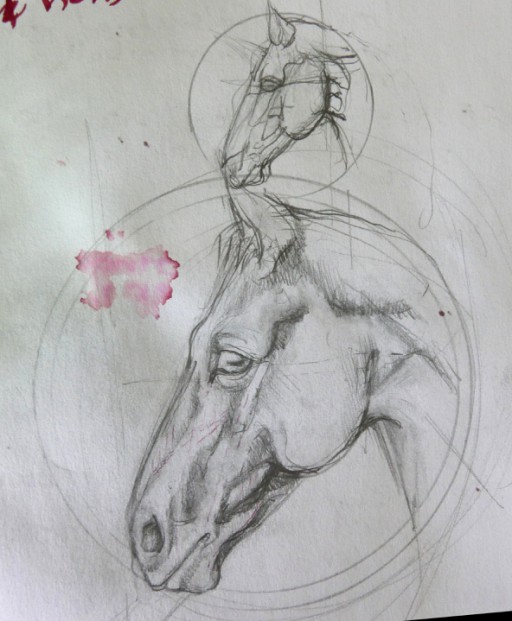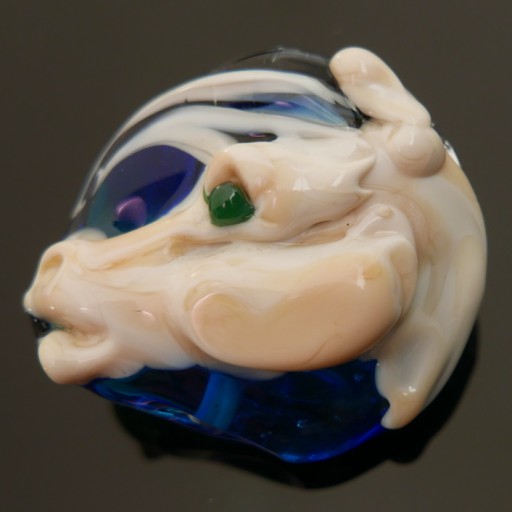For assorted reasons, one being that I thought it might be cool to encase an opaque representation of a skull inside a transparent bead, I drew the skull on the left—the last time, perhaps, I attempted this project. It didn't get very far. As difficult as I find the horses to do, I find the skulls even more so (not least because I'm considerably less familiar with the skull than the outside appearance of any animal) My interest was drawn to other projects, and after being ignored on my table for months (more likely years) I packed up the Munshower notes & shelved them.

Drawing after horse skull, left; sometime between 2015 and ...2019? (more likely much sooner); musculature after Goldfinger, 12 or 13apr20.
But, then, as I explained last time I got interested again, & spent a frustratingly long time looking for the folder (before finding it where I dimly remembered putting it—let it never be said that I'm necessarily good at seeing what's right in front of my face); then, after my (extremely) moderate successes, I decided it was time to really dig into horse anatomy, past what my class notes provided. I'd obviously meandered down this road before, as shown in the sketch of a skull I made awhile back: understanding the underlying skeletal and muscular structures is essential to successfully doing realistic drawings of animals with both.[1]

Assorted horsehead sketches from photographs, showing facial musculature. 12?apr20; photographed 14apr20, Lumix LX100, cropping & exposure adjustments.
But I'd never got very far down that road; and, after looking at a bunch of Munshower's beads, and then a bunch of photos of real horses, I noticed even though we had one set of instructions, neither her beads nor the horses themselves consistently looked like them. What was going on? What were those bulges running from mouth to cheek?
I spent hours looking at stills and video, trying to answer this question. After all, they echoed the horse's jaws—could they be its teeth? (Yes, I did actually entertain this theory.)
Eventually, a little thought—I mean, people have muscles covering their teeth, d'oh!—I figured these had to be muscles. I had finally looked, really looked, at enough models to be able to frame the question.

sketch after photograph, showing proposed life size and larger version of musculature for bead. 13apr20. Graphite. Larger drawing measures approx 3.75"/9.5cm across
Nothing, for me at least, works better than drawing for really seeing how something is put together[2] , and only after making the drawings did I have the mental framework to slot in the answer, how is a horse's face put together? Then I could actually see all the stuff in Goldfinger, instead of my eyes (& brain) just stuttering from information overload and sliding right past it.[3] (Not only did the Goldfinger have the info I was trying to recreate with my sketches—so did Munshower —all I had to do was look over steps 10–13! I have a real gift for failing to see right what's in front of my face...
It's really kind of interesting, the way my mind slides right past answers I need until I know how properly to ask the questions.[4]
So after copying the Goldfinger, I picked a photographic model[5] I made a careful full-size and over-size sketch, went back into the studio, warmed up with some dot and gravity beads, even a couple of bead curtain horseheads in clear glass that went reasonably well, and attacked the assignment, a Munshower style opaque horse head, but simplified.
And crashed and burned.
Le sigh.
And now that I've documented this lot, I've run out displacement activities excuses for getting back in that studio and failing some more. Ugh. This part (aka practise) is frustrating, because there are no shortcuts.[6]
[1]So, okay, something like a manatee that has so much surface softening—say, a thick coating of fat, fur or feathers—is simplified to the point that you might be able to skip this step. Maybe. Usually, there's some points—claws on a fluffy bird, frex, or eyes or nose, that still requires sharp attention to detail.
[2]I suppose if I ever learn to sculpt that will be even more effective...
[3]I actually tried looking this stuff up in that Dover reproduction of Stubbs first, and sho'nuff, more skittering; fortunately for me, the Goldfinger is more diagrammatic, and thus easier to follow, if not as beautifully rendered.
[4]This happened with French Beaded flowers, too, btw.
[5]that I can't show, because copyright, sorry—it's just a nicely photographed horse head with good shadowing showing the musculature clearly—there are tons of such pix on pintrest.
[6]Eventually, if I keep at it, it will get easier; the question is, will I persist long enough to actually learn the material, or get distracted give up and fall back to something easier?
Unless otherwise noted, text, image and objects depicted therein copyright 1996--present sylvus tarn.
Sylvus Tarn